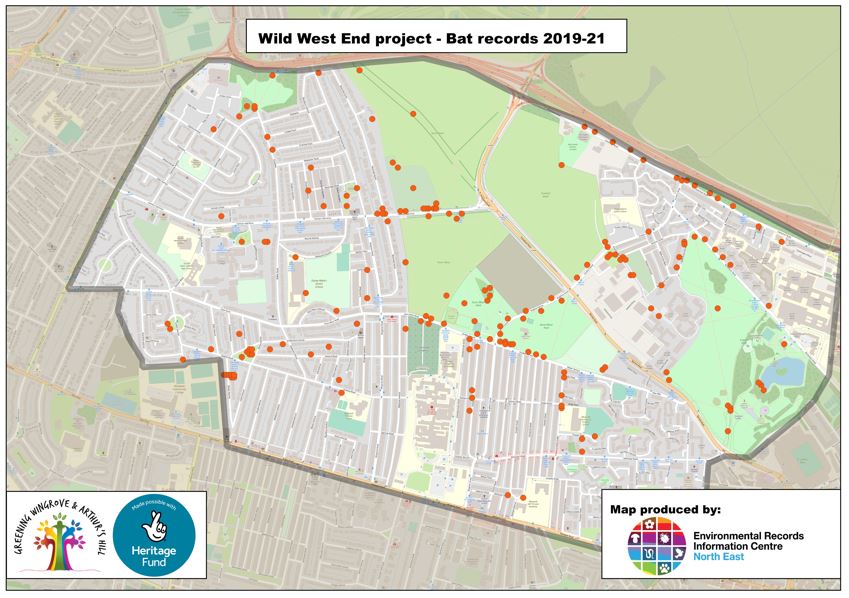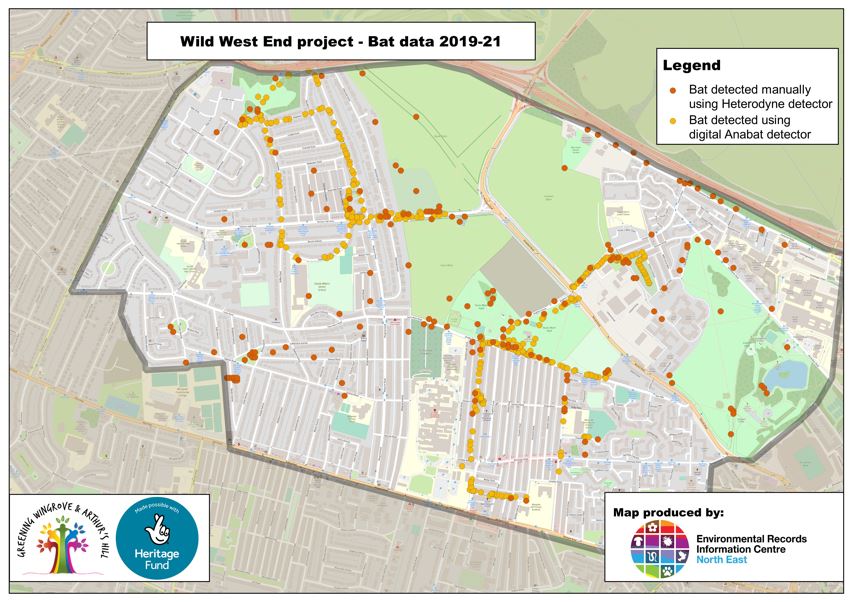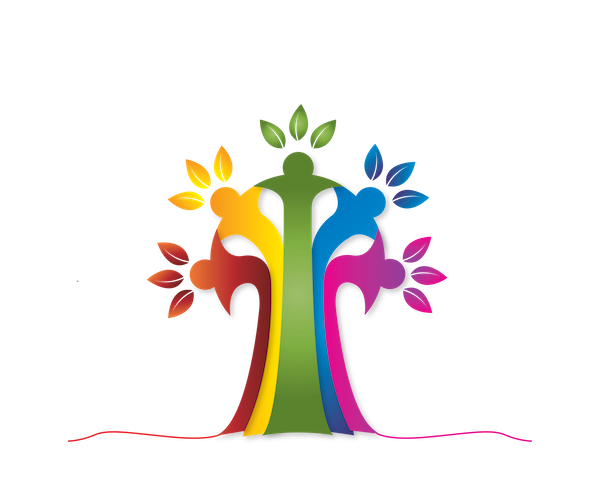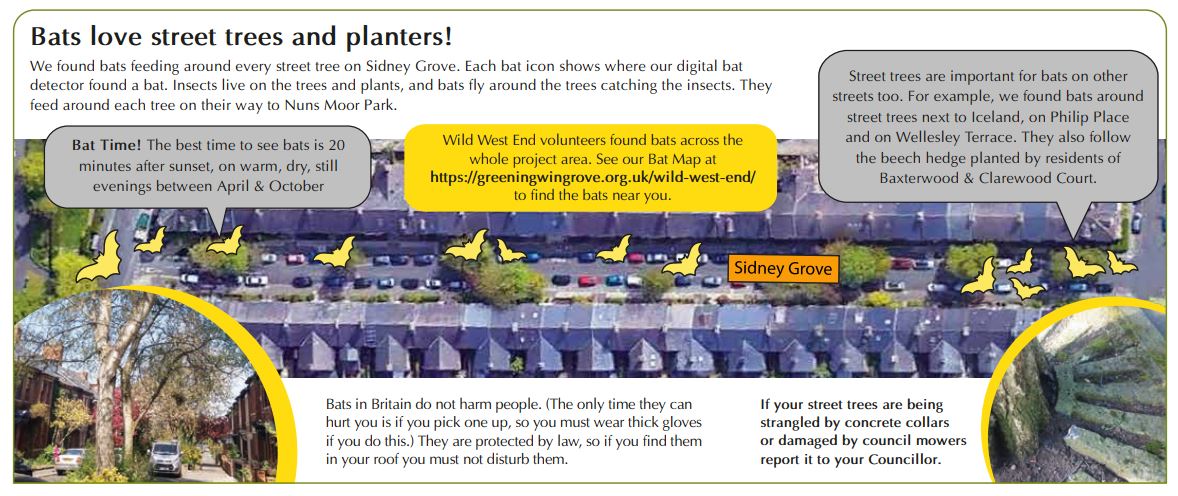Wild West End
Bats love street trees and planters!
Wild West End volunteers and residents found Pipistrelle bats in many places across the Wingrove and Arthur’s Hill wards, but we found them most often in the places that have trees, long grass and other plants. The bats were flying around catching and eating the insects that live on the plants.
We didn’t manage to find the buildings where the bats roost (sleep and
hibernate in the winter) but we know there must be roof spaces that are ideal for them to sleep in or we wouldn’t have any bats!
Map 1 below shows where we found bats using a heterodyne bat detector. This makes a noise when it locates the echolocation calls of a bat. Volunteers then wrote down where they heard the detector make a noise. Sometimes they could see the bat as well. This information was given 8 figure grid references and given to the Environmental Records Information Centre at The Hancock museum who made the maps.
Map 2 shows where we found bats using an anabat detector. This silently records a bat echolocation call. We then downloaded the data and produced maps from it. To enlarge the maps and graphic press Ctrl and plus on your keyboard at the same time.


As well as volunteers collecting what we called incidental bat records (this is when volunteers walked around streets and parks looking for bats in places where they thought they might find them) we also collected data by regularly walking three routes (transects). These routes were around in Arthurs Hill, Spital Tongues and Fenham (covering the park behind Morrisons and the St. James and St. Basils’ Church Garden).
As these transects were walked a number of times in the summer and autumn of 2020 and 2021 we collected more data for these streets. It is possible to work out the transect routes on Map 2.
Due to difficulties downloading data from the anabat detectors we only have anabat data for the Arthur’s Hill and Fenham transects, and not for the Spital Tongues one.
If any one would like to analyse our anabat data in more detail, you would be very welcome. Please contact hello@greeningwingrove.org.uk or wildwestend@greeningwingrove.org.uk
Ruth Hayward, Wild West End Project Officer, Nov 2021
____________________
Bat Surveying 2020 is now underway!
If you are out in the evening keep an eye out for bats!
Bats can usually be seen from 20 minutes after sunset. There is a period of about half an hour when you can see them before it gets too dark.
Most of the bats in the Wild West End are one of the two pipistrelle species but there may be other species, particularly in Leazes Park.
The best time to see them is on warm evenings with little wind. They often follow hedge or tree lines or fly over grassy areas. You will see them darting about catching flying insects, which is what they feed on.
The sooner you see them after sunset, the closer their roosting (sleeping) place will be. Also, if you see them coming from a certain direction close to sunset, that may indicate their roost is in that direction, which is why we ask about the direction and time when you see the bats.
Finding bat roosts is an important part of the project so we can protect them.
Summer bat roosts are likely to be in buildings; bats will use buildings of all ages. Pipistrelle species bats are crevice roosting bats and so will be tucked up behind fascia boards, along wall tops, under lead flashing and under roof tiles/slates. Pipistrelles rarely use loft spaces.
Please record your sightings on this downloadable record sheet
Bat incidental recording form complete
or contact the project wildwestend@greeningwingrove.org.uk or phone/text 07410 944713 and I will drop some through your letterbox.
If you take a torch to help you write down your sightings and not trip over!..make sure to not shine it at the bats.
If you want to write down the temperature for when you were out, it can be found here
https://www.weatherhq.co.uk/weather-station/newcastle-3
Circle the weather conditions for each night you record bats on the record sheet.
Please return your record sheets to Ruth Hayward c/o The Time Exchange, 235 Stanton St, Newcastle upon Tyne NE4 5LJ once the office has reopened after lockdown. Please return all record sheets by mid October.
Safety tips
Take a friend – but stay 2 metres apart.
Take a mobile phone and make sure it is charged.
Only walk where you feel safe.
Bat Tansects
The Project also has three transects/routes being walked once a month with bats being recorded using our new Anabat bat recorders. These transects are in Arthurs Hill, Spital Tongues and Fenham (covering the park behind Morrisons and the St. James and St. Basils’ Church Garden).
I did the transect in Arthurs Hill on Monday evening 1st June and found lots of bats in the part of Nuns Moor around the Play Centre.
RH
picture © Michael Mueller 2018, reproduced under CC Attribution 2.0 licence

